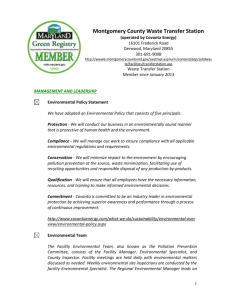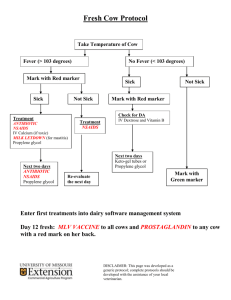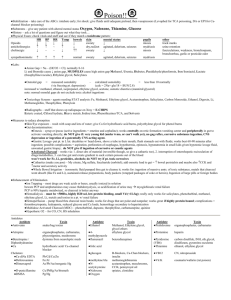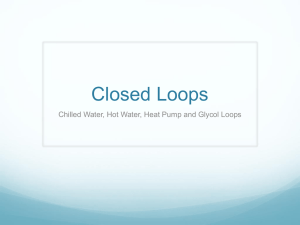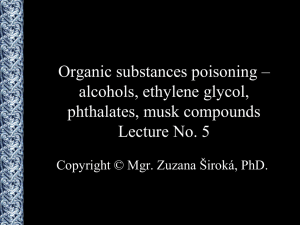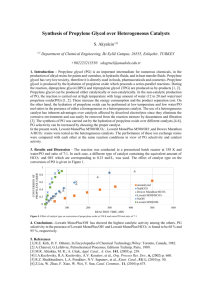Used Antifreeze and Oil mixtures in Geonor/Pluvio gauges
advertisement
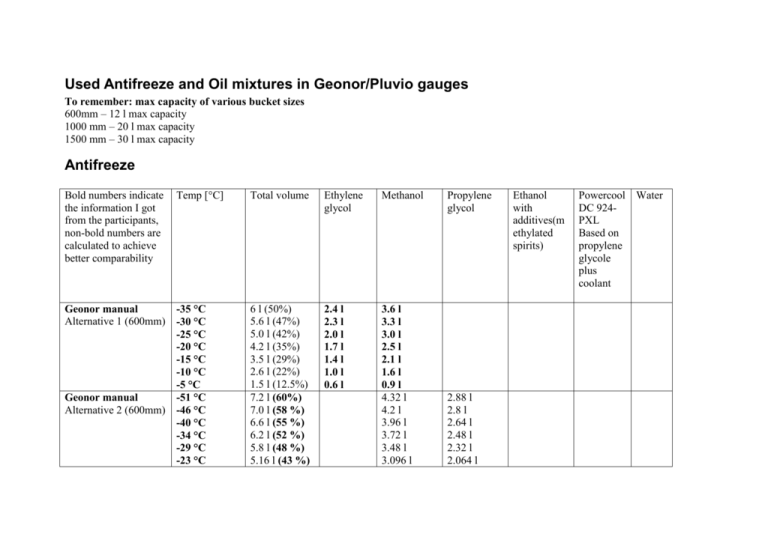
Used Antifreeze and Oil mixtures in Geonor/Pluvio gauges To remember: max capacity of various bucket sizes 600mm – 12 l max capacity 1000 mm – 20 l max capacity 1500 mm – 30 l max capacity Antifreeze Bold numbers indicate the information I got from the participants, non-bold numbers are calculated to achieve better comparability Temp [°C] Geonor manual -35 °C Alternative 1 (600mm) -30 °C -25 °C -20 °C -15 °C -10 °C -5 °C Geonor manual -51 °C Alternative 2 (600mm) -46 °C -40 °C -34 °C -29 °C -23 °C Total volume Ethylene glycol Methanol 6 l (50%) 5.6 l (47%) 5.0 l (42%) 4.2 l (35%) 3.5 l (29%) 2.6 l (22%) 1.5 l (12.5%) 7.2 l (60%) 7.0 l (58 %) 6.6 l (55 %) 6.2 l (52 %) 5.8 l (48 %) 5.16 l (43 %) 2.4 l 2.3 l 2.0 l 1.7 l 1.4 l 1.0 l 0.6 l 3.6 l 3.3 l 3.0 l 2.5 l 2.1 l 1.6 l 0.9 l 4.32 l 4.2 l 3.96 l 3.72 l 3.48 l 3.096 l Propylene glycol 2.88 l 2.8 l 2.64 l 2.48 l 2.32 l 2.064 l Ethanol with additives(m ethylated spirits) Powercool Water DC 924PXL Based on propylene glycole plus coolant Canada Geonor 600 mm, Late fall and early spring load New Zealand Geonor 1000mm Norway Geonor 600mm Norway Geonor 1000m USA Geonor 600mm -20 °C -18 °C -12 °C -7 °C -3 °C 4.8 l (40 %) 4.3 l (36 %) 3.6 l (30%) 2.4 l (20 %) 1.2 l (10 %) 2.88 l 2.58 l 2.16 l 1.44 l 0.72 l 1.92 l 1.72 l 1.44 l 0.96 l 0.48 l -10°C -5°C 3 l (25%) 2 l (17%) 1.8 l (60%) 1.2 l (60%) 1.2 l (40%) 0.8 l (40%) -25 °C -10 °C -25 °C -34 °C -29 °C -23 °C Boulder Testsite (from Bruce’s table) Pluvio2 Ott manual (200cm3, 1500mm) Switzerland Pluvio2 Ott (200cm2, 1500mm) Finland Australia 181mm ~3.62 l (18 %) 5 l (42%) 2 l (40%) 2.5 l (21%) 1 l (40%) 8.3 l (42%) 3.3 l (40%) 6.2 l (52%) 5.8 l (48%) 5.16 l (43%) 4.8 l (40%) 50% 50% 3 l (60%) 1.5 l (60%) 5 l (60%) 3.72 l (60%) 3.48 l (60%) 3.096 l (60%) 2.48 l (40%) 2.32 l (40%) 2.064 l (40%) 2.88 l(60%) 1.92 l (40%) -34°C - -6°C -34°C - -10°C -34°C - -15°C -40°C - -12°C 5.5 l (18%) 8.5 l (28%) 11 l (37%) 10 l (33%) > -58°C -18 °C 5 l Meltium = Kalium formate liquid (49-51% concentration) Glycolbased (35%) 5l 7.5l 10 l 7.5 l 0.5 l 1l 1l 2.5 l ETI NOAH II not further specified Oil General Recommendations: Low pour hydraulic oil, that do not become vicious in the temperature ranges anticipated (from Geonor) Don’t use Canola oil in Bear Country! Change the oil at least once a year Geonor Manual (600mm, 1000mm) Canada New Zealand Norway (600mm,1000mm) USA – Marshall Switzerland Finland Australia Volume 0.4 l Type Esso (Exxon) UNIVISJ13 Temp-range 0.5 l ”a little” 5W30 weight motor oil BP Enerpar M002 (viscosity 15) or M006 (viscosity 68) Safe for consumption if in contact with food Statoil Hydraway 15LT Super Hydraulic Oil -15 to -20 °C FMO-85 mineral oil -5 - -15°C 0.4 l 0.47 l ? Summary Mayo 1971 explains anti-freeze solution used in precipitation gauges should be self-mixing as soon as ice comes in contact with the solution to ensure fast smelting of ice entering the gauge. A solution is self-mixing if its solution density is between 0.796 and 1.116 kg liter^(-1) at 20°C. Geonor recommends a 40/60 mixture of either ethylene glycol plus methanol or propylene glycol and methanol. The table provided from Geonor is giving amounts for different minimum temperatures. For be effective at the same temperature, you have to use slightly more of the propylene glycol mixture than of the ethylene glyco mixture. Propylene glycol is less toxic than ethylene glycol. Methanol is toxic. The mixture requires an oil layer for preventing evaporation, especially of the methanol. Canada and US are using the propylene glycol mixture suitable for their temperatures, Norway is using the ethylene glycol recommendation. New Zealand is filling with a 50/50 mixture of propylene glycol and methylated spirits. I could not find any information on the temperature range and characteristics of that mixture Ott recommends to use powercool for the Pluvio2. Powercool is hygroscopic and has to be mixed with water to prevent that the antifreeze is ”collecting” water from the environment. An oilfilm is not recommended, as methanol is not used. Switzerland, who is using a Pluvio2 is not using powercool, but a propylene glycol and water mixture which has a freezing point range from -40°C to -12°C (for a filled bucket). I am not sure about the self-mixing abilities of powercool or the propylene glycol/water mixture. Densities are in the range stated by Mayo (1971), but higher the density of the 40/60 mixure using glycol/methanol. Probably the self-mixing abilities shrink as the bucket is getting filled. On the other hand do I expect that Ott and the countries using the Pluvio2 as a precipitation gauge would have reported serious icing and changed the used antifreeze. Recommendations Generally, I do think that countries have found a solution that works for their temperature ranges and that obeys national regulations about uses of chemicals, as not using an effective antifreeze would destroy their gauges. I do believe that in case we do document the solution and its characteristics for each gauge, we will get comparable results for all sites. I do recommend an oil film for all gauges (also the Ott Pluvio2) as that prevents evaporation and would also mechanically minimize the hygroscopic effect of the powercool or propylene glycol/water mixture. The amount of initial water could be reduced when using oil as a top layer. I do recommend the use of hydraulic oil, as several countries have reported that experiments with less dangerous oils were not successfull. However, I do want to point out its dramatic impact on the environment in case of oil spills. Carefull handling and disposing of the waste has to be mandatory! Anyway, regulations in some countries or areas possibly don’t allow the use of hydraulic oils and we therefore have to think of an alternative. Maybe New Zealand can share their experiences with their less dangerous oil-alternative. If the IOC wants to request the use of a ”reference” antifreeze or just needs a recommendation for those countries who haven’t any experiences with the use of antifreeze, I would recommend the use of propylene glycol/methanol solution as I feel that it is widest tested and its self-mixing characteristics are well-documented. It is necessary to use a layer of oil on top of that to prevent evaporation Bibliography Mayo, L. R. 1971: Self-Mixing Antifreeze Solution for Precipitation Gages. Journal of Applied Meteorology, 11(2), pp. 400-404.
